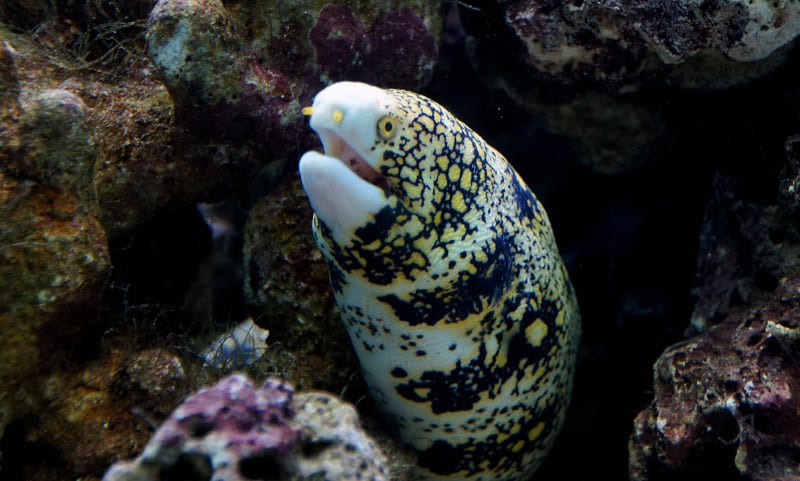
Snowflake Moray Facts
- This amazing creation of Nature and evolution most frequently goes by the descriptive common name of the Snowflake Moray. It also has another occasionally used moniker, though. That’s the somewhat less attention-grabbing term of clouded moray.
- Among scientific professionals, however, it’s typically better known by its formal name. That’s a fairly simple name, too, at least compared to many of its relatives. That’s because this unique marvel of the seas bears the technical name of Echidna nebulosa.
- The impressive animal further received that name due to the efforts of the renowned Swedish researcher, Jonas Niclas Ahle. He accomplished the first official recognition of the creature as a separate and distinct species. This occurred in the year 1789.
- Most fortunately, the beautiful Snowflake Eel appears to be maintaining a population base that’s both sizeable and stable. This additionally seems to hold true throughout its native range. The IUCN, therefore, presently lists it as Least Concern on its Red List.
- This intriguing fish nevertheless does face some potential threats to its continued existence, at least. Like many species, the majority of these stem from human activities. Its greatest threat, though, likely consists of climate change, again like most animals.
Related Articles
Snowflake Moray Physical Description
Like many of its close cousins, the visual marvel known as the Snowflake Moray easily captivates those who encounter it. Also like the majority of those same relatives, it does so for a variety of reasons. In its case, though, one specific physical difference stands out.
That occurs due to the simple physical size of this particular species of eel. More specifically, this fish attains a much smaller overall size than the greater part of its Family. Nature, however, packed plenty of other remarkable attributes into its comparatively small frame.
The animal also mimics most of its kind in the fact that it diplays a certain amount of sexual dimorphism. In its case, though, this trait manifests in a most unusual, and highly specific, manner. For starters, all individuals of this species begin their lives as female!
Some individuals change their gender to male later in life. This typically occurs once the specific specimen reaches a certain size, but varies. Females usually possess slightly smaller teeth than their male counterparts. Otherwise they remain indistinguishable in appearance.
Both sexes of the Snowflake Moray reach a maximum known length of only 39 in (1 m). Most individuals do not attain that size, however, In fact, the great majority of specimens do not even approach this. An average body length measures approximately 20 in (50 cm).
Most display a white snout. Most of the rest of the body manifests yellow and brown shades. A black-striped and speckled pattern additionally appears. The snowflake-like pattern that also apears along its length obviously serves as the source of the common name.
- Kingdom: Animalia
- Phylum: Chordata
- Class: Actinopterygii
- Order: Anguilliformes
- Family: Muraenidae
- Genus: Echidna
- Species: E. nebulosa
Snowflake Moray Distribution, Habitat, and Ecology
Another fact about the animal stands out, both for the Snowflake Moray itself, and those who appreciate the wonders of Nature. That pertains to its area of distribution in the wild. Fortunately, it inhabits a comparatively broad swathe of the marine waters of the globe.
That’s true because it evolved as native across the entirety of the Indo-Pacific region. More precisely, its known habitat range extends from the east coast of Africa across Micronesia. That region even includes the Red Sea and waters around the Hawaiian Islands.
It currently remains undetermined if it ever appeared beyond this area. Once more following a pattern common to its kind, it also evolved as endemic to a very precise range of depths. The intriguing eel lives at depths ranging from 157 ft (48 m) to as shallow as 3.3 ft (1 m).
Even there, the species displays decided preferences for its surrounding environment. That’s true given the fact that specimens most frequently inhabit beds of seagrass and areas of rocky rubble. It also enjoys inhabiting shallow tide pools and intertidal reef flats.
The fascinating Snowflake Moray predominantly feeds as a nocturnal predator. Its favorite prey, which accounts for a large majority of its diet, consists of various small crustaceans. Uniquely, it sometimes even ventures onto land for brief periods to hunt its prey!
The remarkable animal, in turn, has very few natural predators itself. In Nature, typically only barracuda or sharks form threats. It also seems to have a respectable lifespan among its kindred. Though that’s unknown in the wild, captive specimens live for up to 15 years.
Species Sharing Its Range
Check out our other articles on Chinese Giant Salamander, Northern Flying Squirrel, Vintgar Gorge, Petra Iris, Army Green Moth, Philippine Cobra, Hyacinth Macaw, Hellbender Salamander
